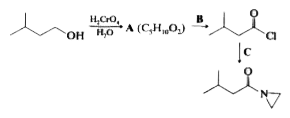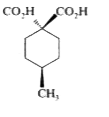Complete Solutions to SOLVED PROBLEM of chapter CARBOXYLIC ACIDS AND THEIR DERIVATIVES of Class 12 book with complete answers and questions
| Class 12 | CHEMISTRY |
| Chapter | CARBOXYLIC ACIDS AND THEIR DERIVATIVES |
| MS CHOUHAN | SOLVED PROBLEM |
| Number Of Questions | 23 |
| Academic Year | 2023-24 |
Which carboxylic acid would ou expect to be stronger A or B ?

View SolutionSuggest epxplanation for the following
The `pK_(a1)` for all of the dicarboxylic acids in Table 17.2 is smaller tyhan the `pK_(a)` for a monocarboxylic acid with the same number of carbon atoms.
View SolutionSuggest epxplanation for the following
The difference between `pK_(a1) and pK_(a2)` for dicarboxylic acid of the type `HO_(2)C(CH_(2))_(n)CO_(2)H` decreases as n increases.
View SolutionN,N-Diethyl-3-methylbenzamide (also called N,N-diethyl-m-toluamide. Or DEET) is used many insect repellants. Write its structure.
View SolutionGive stereochemical formulas for A-D. are enantiomers of each of other.

View SolutionProvide the missing compound A-C, in the following synthesis

View SolutionAt first glance the conversion of bromobenzene to benzenitrile looks simple just cary out a nucleophilic substitution using cyanide ion as the nucleophile. Then we remember that bromobenzene does not undergo either an `S_(N)1` or an `S_(N)2` reaction (Section 6.14A). The conversion can be accomplishes. however. thogh it involves severals steps. Outline possible steps.
View SolutionProvide structures for A and B.

View SolutionIdentify the product obtained when following acids, undergo prolonged heating,

View SolutionIdentify the product obtained when following acids, undergo prolonged heating,

View SolutionIdentify the product obtained when following acids, undergo prolonged heating,

View SolutionIdentify the product obtained when following acids, undergo prolonged heating,

View SolutionIdentify the product obtained when following acids, undergo prolonged heating,
`PH- overset(O)overset(||)(C)-CH_(2)-overset(O)overset(||)(C)-OH`
View SolutionIdentify the product obtained when following acids, undergo prolonged heating,

View SolutionIdentify the product obtained when following acids, undergo prolonged heating,

View SolutionIdentify the product obtained when following acids, undergo prolonged heating,

View SolutionFollowing `beta` ketoacid will not undergo decarboxylation on heating Give reasons.

View SolutionProvided detailed curved arrow mechanisms for the following reactions:

View SolutionProvided detailed curved arrow mechanisms for the following reactions:

View SolutionProvided detailed curved arrow mechanisms for the following reactions:

View SolutionProvided detailed curved arrow mechanisms for the following reactions:

View SolutionProvided detailed curved arrow mechanisms for the following reactions:

View SolutionProvided detailed curved arrow mechanisms for the following reactions:

View Solution
SOLVED PROBLEM questions and complete solutions for chapter CARBOXYLIC ACIDS AND THEIR DERIVATIVES of MS CHOUHAN CHEMISTRY (HINGLISH) of Class 12